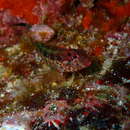Biology
provided by Fishbase
Lives in rocky, boulder strewn areas and walls. Prefers tide pools and shallow water habitats (Ref. 5227).
Comprehensive Description
provided by Smithsonian Contributions to Zoology
Malacoctenus tetranemus (Cope)
Blennius tetranemus Cope, 1877:42 [Pacasmayo Bay, Peru; types lost].
Labrisomus afuerae Hildebrand, 1946:400 [Lobos de Afuera Island, Peru; holotype USNM 128213].
Malacoctenus afuerae multipunctatus Springer, 1959:462 [southwest end of San Lucas Bay, Baja California; holotype CAS SU 49596].
This species, as Malacoctenus afuerae, has been adequately described and differentiated by Springer (1959).
The depository of the holotype of Blennius tetranemus was not given in the original description, but most logically would have been the Academy of Natural Sciences, Philadelphia. Repeated searches of that collection, and many others, have failed to locate the holotype. The description clearly applies to a clinid as no other family of fishes exhibits the combination of dorsal- anal- and pectoral-fin element combinations, dorsal-fin shape and position, disposition of head cirri, and color pattern. Of those clinids known from Peru it could only apply to Labrisomus multiporosus or Malacoctenus afuerae, both well-known, but infrequently reported, species. Both of these names are more recent than tetranemus and are thus in jeopardy. We therefore prefer to recognize Blennius tetranemus as a senior synonym of Labrisomus afuerae and to stabilize the nomenclature by designating the holotype of L. afuerae as the neotype of B. tetranemus. As a result of this action L. afuerae is an objective junior synonym of B. tetranemus.
Malacoctenus afuerae multipunctatus was believed to be restricted to the Pacific coast of Mexico north of the Gulf of Tehuantepec, and was differentiated from the nominal subspecies in having the belly densely spotted, as opposed to lacking spots on the belly. Recently collected specimens of M. tetranemus from Ecuador and the Galapagos Islands (new locality records for the species) exhibit variation in the amount of spotting on the belly, ranging from dense to absent. Recently collected specimens from Peru either lack spotting or have broad dark markings on the belly. In view of the large variation of color pattern within a population we do not believe that subspecies in M. tetranemus are warranted.
RANGE.—From the northern end of the Gulf of California to the Lobos de Afuera Islands, Peru.
MATERIAL (in addition to that reported by Springer, 1959).—Ecuador: Bahia Santa Elena, USNM 207595 (1:59); Galapagos Islands: USNM 205842 (22:29–49); Peru: Lobos de Afuera Islands, USNM 205843 (11:42–72).
- bibliographic citation
- Stephens, John Stewart and Springer, Victor G. 1973. "Clinid fishes of Chile and Peru, with description of a new species, Myxodes ornatus, from Chile." Smithsonian Contributions to Zoology. 1-24. https://doi.org/10.5479/si.00810282.159
Malacoctenus tetranemus: Brief Summary
provided by wikipedia EN
Malacoctenus tetranemus, the throatspotted blenny or chameleon clinid, is a species of labrisomid blenny native to the Pacific coast of the Americas from the Gulf of California to Peru as well as around the Galapagos Islands. It inhabits rocky areas where it lives in tide pools and shallows generally at depths of from 6 to 23 metres (20 to 75 ft). This species can reach a length of 7.5 centimetres (3.0 in) TL.
- license
- cc-by-sa-3.0
- copyright
- Wikipedia authors and editors

